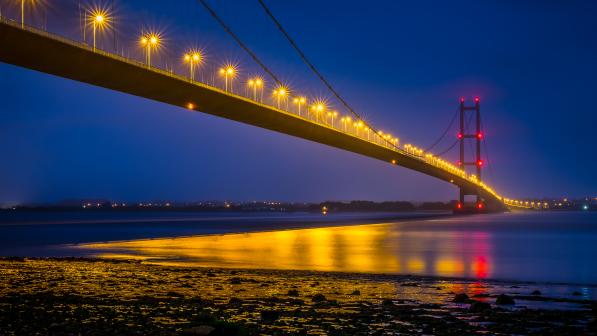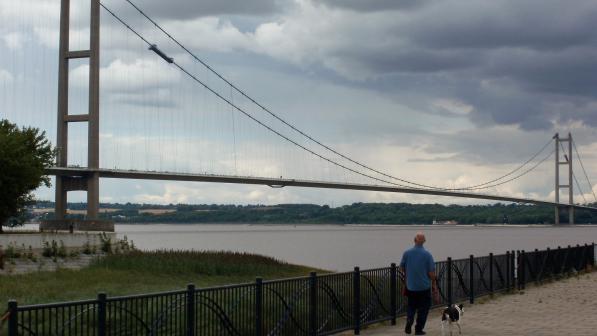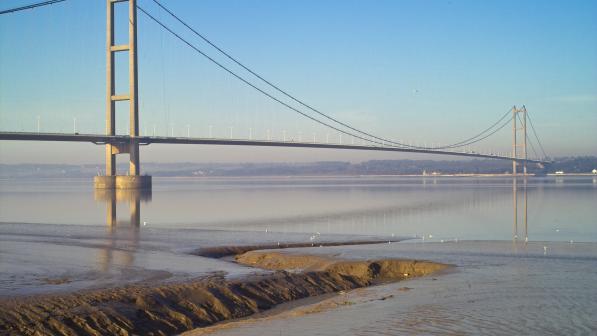Humber Bridge: Banning cyclists and pedestrians instead of investing to save lives

After closing the Humber Bridge to cyclists and pedestrians nearly a month ago, the Chair of the Board Sean Chaytor wrote to me claiming that the Board had used emergency powers under the Humber Bridge Act to do this, but that before reopening the combined footway and cycleway, the Board had to be satisfied that there would be no more tragic incidents.
I’ll park the question of whether or not the Board does actually have the power to do this without making a traffic regulation order, or if indeed it does, whether it has exercised those powers reasonably, because I want to focus on the Board’s hypocrisy: banning cyclists and pedestrians whilst failing to take the infrastructure measures needed to address a horrific and chronic concern.
In a nutshell, the Board wants to be seen to be doing something, but doesn’t want to do anything that costs any money.
Appalling and tragic loss of life
The incidents Mr Chaytor was referring to involve the horrific loss of life when people in the depths of despair have jumped from the bridge. Nothing I am about to write is meant to minimise how horrendous this is for the people concerned, their loved ones, and for first responders. However, given that the Board’s response to a long-term problem has been to exclude cyclists and pedestrians from the bridge indefinitely, I have to talk about numbers, reports and evidence – which is horrible when talking about such appalling loss of life.
Firstly, if Mr Chaytor wants certainty that there will be no more tragic incidents, unless and until the Board addresses the infrastructure issues, including the parapet height along the footway, he’s going to have to close the bridge to all traffic. That’s because people have jumped off the bridge having walked onto and along the footway, having driven or been driven onto the bridge, and in one instance I could find, having cycled onto the bridge.
When working out how to deal with a surge in the number of suicides at the bridge, you’d assume that the data would be key, but it’s actually extremely difficult to get to the bottom of how many people have died in such incidents, how they’ve accessed the bridge, and at what time of day or night (relevant because restrictions on access at night-time might have been a temporary option to consider).
A petition recently set up to press the Board to provide more safety measures does however, mention in excess of 200 deaths, with various press reports referencing seven or eight fatalities a year, though surprisingly, the data is sketchy to say the least. One report I read referenced the police saying there had been five deaths from the bridge during the same period the Maritime and Coastguard Agency were aware of at least 13.
There is a Freedom Of Information (FOI) request pending to try and secure answers to some of these questions; however I’m still waiting for a response to my FOI request, and as we reported last week, we’re still awaiting answers to pretty much every other question we’ve asked the Board since 3 April.
The railings are just too low
I mentioned the parapet height along the footway, so I’ll start there. It’s 1.165m high, below the 1.4m minimum parapet height for bridges used by cyclists set out within the Design Manual for Roads and Bridges, and below the 1.3m minimum for bridges used by pedestrians where there are likely to be windy conditions, which is clearly the situation for a bridge over 2 miles long spanning an estuary.
I’ll concede immediately that increasing the parapet height on a bridge such as this is a huge undertaking (increased wind resistance, structural load etc), however, questions around low parapet height, high suicide rates, and what to do about it aren’t unique to the Humber Bridge.
Back in 2010, there was a surge in incidents at the Erskine Bridge north-east of Glasgow. Instead of banning cyclists and pedestrians - a course of action I can’t find any precedent for on any other major bridge - they spent the money to raise the parapet height from 1.2m to 2.4m, completing the work in nine months.
A location of concern study on the Erskine Bridge commissioned by NHS Scotland reported the dramatic reductions in suicides following the parapets being raised, from 16 suicides in the two years prior to installation to three in the subsequent two years. Those statistics (and I apologise for talking about statistics in the context of such personal tragedy) aren’t however surprising, because that’s what the evidence tells us happens. The Humber Bridge Board know this, because tucked away on page 85 of the agenda papers for the Board meeting on 27 September 2019 is the reference within the minutes of their last meeting on the discussion about raising the barriers, and the detailed research by Hemmer, Meier and Reich comparing different suicide prevention measures at bridges and buildings.
The key point in the context of the Humber Bridge, is that the research shows that the most effective method of reducing suicides is to install safety nets below the point of jumping (77.1% reduction), whilst increasing barrier height to at least 2.3m gives a 68.7% reduction. It’s worth noting here that Public Health England’s guidance for barrier heights for fencing on bridges and high buildings is that they should be at least 2.5m.
The Board have been aware of the potential to mitigate the devastating loss of life by raising the barrier height for over a decade
Duncan Dollimore, Cycling UK's head of campaigns
Keeping up appearances
The Board’s position in April 2021 seems to be that it has to do something whilst it considers long term solutions, but it has been moving the deckchairs around whilst the ship’s been sinking for over a decade.
It first carried out a trial, increasing the height on a section of the parapet, back in 2009, but the results from the trial don’t appear to have been published - another document I’ve asked for but not received. On page 82 of the September 2019 agenda papers already referred to, the 2009 trial is mentioned, alongside the comment that the raised barrier could have been installed across the whole of the bridge at a cost of around £4 million.
I was tempted when writing this blog to calculate how many people’s lives might have been saved had the Board had taken action ten years ago to increase the parapet height, given the evidence that doing this prevents nearly 70% of suicides, but with at least seven or eight deaths a year throughout that period, I think it’s sufficient to say it’s an alarming number.
Raising the railings – taking it out of the budget
You don’t have to look very hard or for long to find out why it’s not been done. Once again, it’s in the Board’s minutes, this time from 21 February 2014, where at para 87.1 under any other business, it’s noted that Board Directors were reminded that in 2012 that they had resolved not to raise the parapets and had deleted the budget provision.
So, they had a trial, were told it would cost around £4 million to increase the parapet height along the entirety of the bridge, put it in the budget and resolved to do it, then changed their minds.
We’re now being told that the closure of the footway to cyclists and pedestrians was the only option, because it was an emergency, but back in 2019 Mr Chaytor was promising to find out if raising the parapets was "an achievable and affordable way" of reducing suicides on the bridge, and it’s clear from various documents that the Board have been aware of the potential to mitigate the devastating loss of life by raising the barrier height, for over a decade.
But why do that? It costs too much money, and it’s complex. Far easier just to ban cyclists and pedestrians. They don’t pay the tolls anyway, so with any luck, they’ll start crossing in a car and bring in more revenue.
If you live in the East Riding of Yorkshire or Lincolnshire, or if you can’t cross the bridge on foot or cycling, feel free to let the Board know what you think, and your MP. If you live in the constituencies of Emma Hardy, David Davis, Andrew Percy, Martin Vickers or Diana Johnson, they’ve already received a lengthy letter from me about this, asking them to raise this with the Board.




